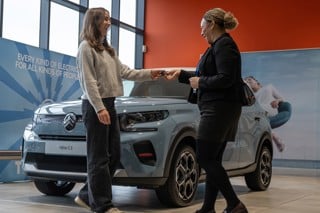The automotive sector is no stranger to the power of tech and it’s often been behind the leading edge of it.
Most recently though, it’s also arguably a casualty of it - certainly when it comes to the traditional business of selling cars and the consumer contact time on which dealerships rely.
The writing was already on the wall prior to the COVID-19 lockdown.
If you’d asked dealers then (as we did) about customer purchase behaviours, they’d attest that customers don’t need to visit the dealership anymore...and they aren’t.
Where once it might have been four-to-five visits to browse, test drive, perhaps get a trade-in valuation, arrange finance, then collect, this has dropped to an average 1.5 visits-per-sale.
We have all become connected consumers and we expect to move seamlessly between platforms, devices and environments as we build relationships with brands and buy products. It’s a shift that’s set to accelerate post-COVID – we’ve been driven online and it’s highly likely more of us will stay there: ‘the new norm’, as the phrase goes.
'Just another shopping mission'
A new car is just another shopping mission, albeit one of the biggest most of us will ever make, but our expectations are no different and they are being reset with every visit.
The car marques are doing a good job, establishing new ways to experience and learn about their models.
The configurator feels rather old, but arguably remains the most important and influential tool in the consumer decision journey; VR is growing in popularity with many brands having downloads available on their sites; then there is the huge array of content, including a rich assortment of educational films explaining the tech and demystifying the next generation of E-Mobility.
When all this is available online, why would anyone venture into a car showroom?
Inevitably, we’ll see far fewer showrooms as brands put greater focus on digital services, and the creation of powerful pop-up experiences and engaging destination stores – all vying for Gen Z business, and all playing a vital role in rejuvenating brands.
It’s happening in retail already: omnichannel commerce is forcing big players to reduce legacy estates as the mobile device redefines customer expectations of retail that must now be everywhere, instant and personal.
Charging opportunity
Dealerships must start thinking like retailers to understand their customers have three budgets: time, money and frustration.
This doesn’t mean the death of the traditional salesman (excuse the pun). Rather, the answer to the challenge we face might just be in the time element to the equation.
The average time to charge an EV is 20 minutes. That has the potential to be 20 minutes with your customer.
Tesla led the charge with the production of the world’s first electric vehicles (EV), and is doing the same again with its near-2000-strong ‘SuperCharger’ EV charging network. It’s also reported that the company aims to launch 4000 new Superchargers in China this year alone, which highlights the fundamental, massive infrastructural change required to facilitate EV adoption.
Porsche is now following hot on its heels, with the announcement in March of its Destination Charging network.
The free service for Porsche’s Taycan and plug-in hybrid model customers comprises over 1,000 charging stations at select hotels, airports, museums, shopping malls and sports clubs, or sites in over 20 countries worldwide, with the aim of growing to 2000 charging locations by the end of 2020.
For brands and retailers, this presents a huge opportunity to either monetise the platform and/or engage innovatively with new-gen customers, giving them a new way and reason to connect. It’s also an opportunity for dealerships to reinvent themselves.
So what might these experiences look like, and how can they be shaped to deliver the most impact and commercial benefit to automotive brands and dealerships?
'Emotionalise' showrooms
A good starting point is with brands with dedicated showrooms: these stand to drive footfall, and rejuvenate and reinvent these ailing spaces by creating modern and unique multimedia EV post-experiences.
This emotionalises showrooms, incentivises visits and provides a vital and enhanced new connection point along the customer journey – all of which last for less than 20 minutes.
Providing entertainment, engagement and education around both electric and legacy fuel ranges, we can imagine voice-activated and AI or AR-driven interactive merchandising applications that integrate with existing showroom brand experience, social and app content and drive the appetite for the next generation of vehicles.
Add pop-up events that showcase new models and depict the brand’s commitment to a greener society and future, not only in showrooms but at existing EV network stations like supermarkets and hotels.
These can provide new acquisition opportunities as well as additional brand exposure beyond the showroom and brand digital experience.
All this holds major currency with society-conscious Gen Z and Millennials, who as well as being connected, actively seek out brand values they can demonstrably align with.
Key to truly connecting with this audience means more than delivering mere ‘Instagrammable moments’, but depth of content and experience that is credible, relevant and educational as well as entertaining.
Perhaps more exciting is the opportunity for dealerships to become brand hubs again, building community around a shared spirit.
Look to brands like Rapha, which has built clubhouses and a successful cycling club and ask yourself: could we see the automotive brands resurrect driving clubs and dealerships, driving new revenues in food and beverage? Because I am sure every F&B retailer with car parking will be thinking this way very soon, if not already.
Compelling experiences
What’s important is that the experiences are sufficiently compelling that they act as an incentive to visit and provide a reason to return and spend 20 minutes in-dealership, again and again.
The dealership as a club house is an exciting proposition as we see more automotive brands explore subscription-based business models.
The 20-minute charge being time to explore and spec the next ride opens the door to more advanced configurators using mixed reality and RFID. We see major opportunity around interactive experiences that bring the EV drive experience to life.
The total transformation of the model that has supplied the combustion engine with fuel is going to be fundamentally disrupted and new players will emerge.
We’re at the tipping point in the decline of traditional showrooms and in E-mobility uptake, and this year we will start to see how exciting, compelling charge experiences that deliver on brand and drive sales can augment, emotionalise and repurpose ailing showroom space.
It is for the automotive brands that dare to innovate to take up the challenge and define the future of automotive retailing.
Author: Simon Hathaway, managing director for EMEA, Outform



















Login to comment
Comments
No comments have been made yet.